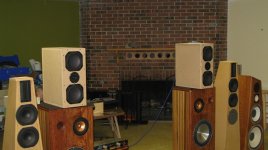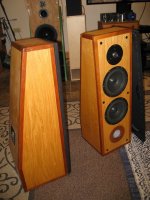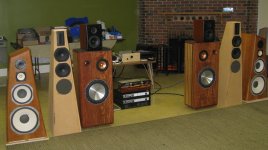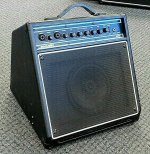Title says it all gents.
Why are these types of enclosures not more common? Especially in the diy arena?
I see Zu and Martens use the shape and even one diy option on the ejjordan site but otherwise very little.
I would have thought the structural integrity and reduction in standing waves made this more popular?
Why are these types of enclosures not more common? Especially in the diy arena?
I see Zu and Martens use the shape and even one diy option on the ejjordan site but otherwise very little.
I would have thought the structural integrity and reduction in standing waves made this more popular?
They are harder to make, that's probably the main reason. I've done a few speakers in truncated pyramids and it takes a bit of time to get all the joints perfect.
Given the lengths some of us go to I'm still suprised they're not more popular.
Is the shape that much more beneficial over your standard rectangle?
Is the shape that much more beneficial over your standard rectangle?
A truncated pyramid has no primary resonant modes in its sides, back or front. A knuckle wrap test sounds quite different to a rectangular box. Diagonally bracing panels in a rectangular box can be difficult too but will also break up the resonant modes.
The truncated pyramid does indeed look tough to make. Would a simpler shape still offer similar benefits? I'm thinking a large Toblerone here?��
"Why are triangular enclosures not more common"
Hi ewollowe,
I've often wondered that too. I did some calculations some time ago and found that for a given cross sectional area, an equilateral triangle shape has a shorter perimeter compared to a circle and more so compared to a square.
This led me to think about the relationship between the volume and surface area of a 3 cornered pyramid shape of enclosure compared to that of a sphere and cube.
To my surprise, the pyramid shape, comprised of 4 equilateral triangle surfaces, required significantly lower surface area compared to the sphere and cube for a given volume!
And as you pointed out, since the internal surfaces are not parallel, this should have a positive influence on standing waves.
Peter
Hi ewollowe,
I've often wondered that too. I did some calculations some time ago and found that for a given cross sectional area, an equilateral triangle shape has a shorter perimeter compared to a circle and more so compared to a square.
This led me to think about the relationship between the volume and surface area of a 3 cornered pyramid shape of enclosure compared to that of a sphere and cube.
To my surprise, the pyramid shape, comprised of 4 equilateral triangle surfaces, required significantly lower surface area compared to the sphere and cube for a given volume!
And as you pointed out, since the internal surfaces are not parallel, this should have a positive influence on standing waves.
Peter
Non-rectangular shapes are often more difficult to fabricate as noted. 😱
That being said, there have been several nice sounding speakers made by various members of the Seattle diy club. A few examples here.
That being said, there have been several nice sounding speakers made by various members of the Seattle diy club. A few examples here.
Attachments
Some lovely examples. Thanks Dave.
I actually picked up an older set of Polk floorstanders cheap for a friend of mine that utilize this kind of shape. Very nice sounding they are too.
These are all obviously much harder to make but as I mentioned earlier what about a simpler triangular shape? Like the Zu and ejjordan designs?
I actually picked up an older set of Polk floorstanders cheap for a friend of mine that utilize this kind of shape. Very nice sounding they are too.
These are all obviously much harder to make but as I mentioned earlier what about a simpler triangular shape? Like the Zu and ejjordan designs?
A single sloping panel like Dave shows in the middle image is fairly easy to do, even double (sides and top) sloping like the outer speakers in the last image are easy enough to calculate, set your saw and cut.
Though pyramids are possible, they are best calculated. If your estimate is out, if your saw setting is inaccurate, if your cut is imperfect, their error is in three dimensions, holding them together for inspection is fiddly. Guessing how to correct them for fit is tricky because every change also changes the whole shape's fit.
Though pyramids are possible, they are best calculated. If your estimate is out, if your saw setting is inaccurate, if your cut is imperfect, their error is in three dimensions, holding them together for inspection is fiddly. Guessing how to correct them for fit is tricky because every change also changes the whole shape's fit.
Clamping up the glue joints is what usually gives me fits. Anything non-orthogonal and the rotten things want to slip out of alignment.
If anybody knows of a brand of inexpensive clamps suitable for compound joints I'd like to hear about them.
Cheers
If anybody knows of a brand of inexpensive clamps suitable for compound joints I'd like to hear about them.
Cheers
Clamping up the glue joints is what usually gives me fits. Anything non-orthogonal and the rotten things want to slip out of alignment.
If anybody knows of a brand of inexpensive clamps suitable for compound joints I'd like to hear about them.
Cheers
I've used band clamps to cinch up around things where bar clamps won't work very well.
There must be a calculation mistake - that cannot be correct. The reason why bubbles are spherical is because the surface-tension of the soap film causes it to shrink to the minimum possible area, given the constraint that it has to enclose the volume of air that's inside.To my surprise, the pyramid shape, comprised of 4 equilateral triangle surfaces, required significantly lower surface area compared to the sphere and cube for a given volume!
If cubes and pyramids had lower surface area for the same internal volume, soap bubbles would be pyramidal or cubic.
I do agree about the sonic advantages of pyramidal / triangular loudspeaker enclosures, though. My inexpensive Acoustic AG-30 acoustic guitar amplifier (intended to also work as a small P.A. system for vocals, keyboards, etc) sounds much less "boxy" than competing products with more typical rectangular-prism shaped enclosures.
The AG30 enclosure isn't exactly pyramidal or triangular, but it has only two parallel sides (the two end walls). The attached photo shows the AG30.
-Gnobuddy
Attachments
Polk Audio LS-70 Speaker System Review price specs - Hi-Fi Classic
These are the old Polks I picked up for a friend that got me thinking. I lived with them for a few enjoyable weeks.
He's very pleased with them, especially for $250 Australian.
These are the old Polks I picked up for a friend that got me thinking. I lived with them for a few enjoyable weeks.
He's very pleased with them, especially for $250 Australian.
Out of curiosity, I decided to do some calculations to see how a sphere and a regular tetrahedron (pyramid with four identical equilateral triangular sides) compared when it comes to volume and surface area.
If "a" is the length of one edge of the triangles making up the tetrahedron, then
Volume of the tetrahedron (Vtet) = (a^3)/(6*sqrt(2))
Surface area of the tetrahedron (Stet) = sqrt(3)*(a^2).
Okay. Now consider a sphere instead.
For a sphere,
Volume (Vsph) = (4/3)*pi*R^3.
Surface (Ssph) = 4*pi*R^2.
So what is the radius of a sphere that has the same volume as a tetrahedron of edge "a"? We can find out by setting the two volumes (Vsph and Vtet) equal, and solving for "R".
Equate the volumes: (4/3)*pi*R^3 = (a^3)/(6*sqrt(2))
Solve for R, lots of messy algebra, the result is:
R = (1/2)*(1/(pi*sqrt(2)))^(1/3) * a
Now we know the radius of a sphere that has the same volume as a tetrahedron (symmetrical triangular pyramid) with edge "a".
We can now plug that messy expression for R above into the formula for the surface area of a sphere. This will give us the surface area of a sphere that encloses the same volume as the tetrahedron.
Lots more messy algebra, and the result is:
Ssph = (pi/2)^(1/3)*a^2
We're almost done - now we have the surface area of a tetrahedron and a sphere, both with the same internal volume. All we have to do is work out the numerical value of that mess of terms in front of (a^2) in each formula (Ssph and Stet). And the result is:
Since 1.732... is bigger than 1.162..., we now know that the surface area of the tetrahedron is bigger than the surface area of the sphere, given both have the same volume.
In other words, the sphere has less surface area for the same enclosed volume than the tetrahedron does.
The same sort of calculation can be done to compare a cube and a sphere, and the result will be the same; the sphere will have less surface area (for the same enclosed volume).
In fact, the sphere is the geometrical shape with the smallest possible surface area for a given enclosed volume. No other shape can do better than the sphere in this regard.
-Gnobuddy
If "a" is the length of one edge of the triangles making up the tetrahedron, then
Volume of the tetrahedron (Vtet) = (a^3)/(6*sqrt(2))
Surface area of the tetrahedron (Stet) = sqrt(3)*(a^2).
Okay. Now consider a sphere instead.
For a sphere,
Volume (Vsph) = (4/3)*pi*R^3.
Surface (Ssph) = 4*pi*R^2.
So what is the radius of a sphere that has the same volume as a tetrahedron of edge "a"? We can find out by setting the two volumes (Vsph and Vtet) equal, and solving for "R".
Equate the volumes: (4/3)*pi*R^3 = (a^3)/(6*sqrt(2))
Solve for R, lots of messy algebra, the result is:
R = (1/2)*(1/(pi*sqrt(2)))^(1/3) * a
Now we know the radius of a sphere that has the same volume as a tetrahedron (symmetrical triangular pyramid) with edge "a".
We can now plug that messy expression for R above into the formula for the surface area of a sphere. This will give us the surface area of a sphere that encloses the same volume as the tetrahedron.
Lots more messy algebra, and the result is:
Ssph = (pi/2)^(1/3)*a^2
We're almost done - now we have the surface area of a tetrahedron and a sphere, both with the same internal volume. All we have to do is work out the numerical value of that mess of terms in front of (a^2) in each formula (Ssph and Stet). And the result is:
Code:
Surface area of tetrahedron = 1.732050808 * a^2.
Surface area of sphere of same volume = 1.162447352 * a^2In other words, the sphere has less surface area for the same enclosed volume than the tetrahedron does.
The same sort of calculation can be done to compare a cube and a sphere, and the result will be the same; the sphere will have less surface area (for the same enclosed volume).
In fact, the sphere is the geometrical shape with the smallest possible surface area for a given enclosed volume. No other shape can do better than the sphere in this regard.
-Gnobuddy
He probably forgot the ground plane of the pyramid...
Furthermore, the before statements about standing waves and panel resonances aren’t true per definition either. Since internal and panel sizes will be bigger, modal problems will mainly shift in frequency and Q.
Furthermore, the before statements about standing waves and panel resonances aren’t true per definition either. Since internal and panel sizes will be bigger, modal problems will mainly shift in frequency and Q.
I find them aesthetically unpleasing - I do have a pair of 'truncated pyramids' in my lounge room, but while building them decided I couldn't handle the look of anything with an angle of more than 7.5 degrees. At least they're more pleasing than those faceted monstrosities that look like wind-blown daleks.....
- Home
- Loudspeakers
- Multi-Way
- Why are triangular enclosures not more common here?



